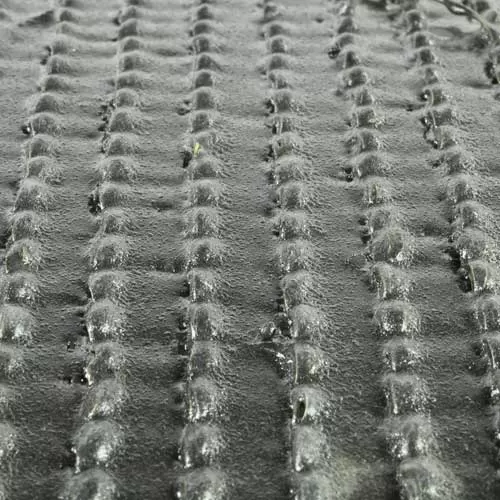Does Artificial Turf Drain?
Related Product: Artificial Grass Turf Ultimate Natural 1-1/2 Inch per SF
Drainage Properties of Artificial Turf

Synthetic turf designed for outdoor use will have some drainage properties, but the drainage speed can vary. Fast-draining turf features a permeable backing with drainage holes to let water through. The closer together the holes are located, the faster liquids can make their way through the backing and into the soil. Artificial grass turf with many holes placed closely in the backing simulates the drainage effects of natural grass.
In contrast, if the turf has drainage holes in the backing placed farther apart, that design causes a slow permeability rate. Excess water and fluids won’t drain through the turf as quickly, and you could face problems like flooding. If puddles form and sit on the turf, bacteria can grow, leading to an unhealthy environment. Plus, if you have standing water on your turf, you can’t use the area soon after a heavy rain.
Installing an Artificial Turf Drainage System

It’s important to plan and ensure that your turf will drain well. A successful outdoor turf installation starts with choosing a fast-draining artificial turf that allows liquids to make their way through the turf backing quickly.
You’ll also need to pair that turf with some sort of drainage system, such as the proper sub-base which will give liquids a place to go once they make their way through the turf. Artificial turf can only drain liquids as fast as its base will allow.
To maximize drainage, consider a drainage tile. Drainage tiles are often made of PVC and feature many holes to let water travel down into the base. The tiles help to avoid a situation where your base is so saturated that the turf can’t continue to drain away liquids.
If you have an uneven surface with low-lying areas likely to flood, installing drainage holes and catch basins can be helpful. To start, you can create a drainage hole that will channel water away from the area’s surface. A catch basin, installed within the hole, collects any extra water, rather than letting it sit at the surface. You will need to empty the catch basin after heavy rains, so it’s important to keep up with the maintenance for this type of system.
Additional Qualities to Look for in Artificial Turf

Drainage is one important quality to consider when choosing your artificial turf project. In addition to drainage, it’s important to look for other qualities to ensure the turf is the right choice for your project.
Pile Height
Consider the pile height, or the length of the turf fibers, when choosing the best product for your needs. A taller pile height creates a more luxurious, comfortable feel, and is suitable for artificial lawns. However, a taller pile height is more easily flattened and needs extra fluffing and maintenance.
When buying turf for a high-traffic area, like a pet area or sports field, a shorter pile height is more durable and less likely to be flattened down. Consider how you use the area and the overall aesthetic and feel you want when deciding on the right pile height.
Thatch
If you’re looking for a highly realistic turf, try to find a product with thatch. Thatch is an extra fiber with a different color, weight, and texture, creating an underlayer in the turf that contributes to its realistic look. Thatch is often a shade of brown to resemble the imperfections in real turf, contributing to a more realistic appearance and feel.
UV Resistance
When buying artificial turf for outdoor use, make sure to choose a UV-resistant product. UV rays can degrade the color of turf, and a UV-treated product is designed to withstand those rays and retain its color.
Warranty
Artificial turf’s warranty can also give you a sense of the quality of the product you’re purchasing. Many turf products are backed by multi-year warranties, giving you the peace of mind that you’re buying a quality product designed to last.



